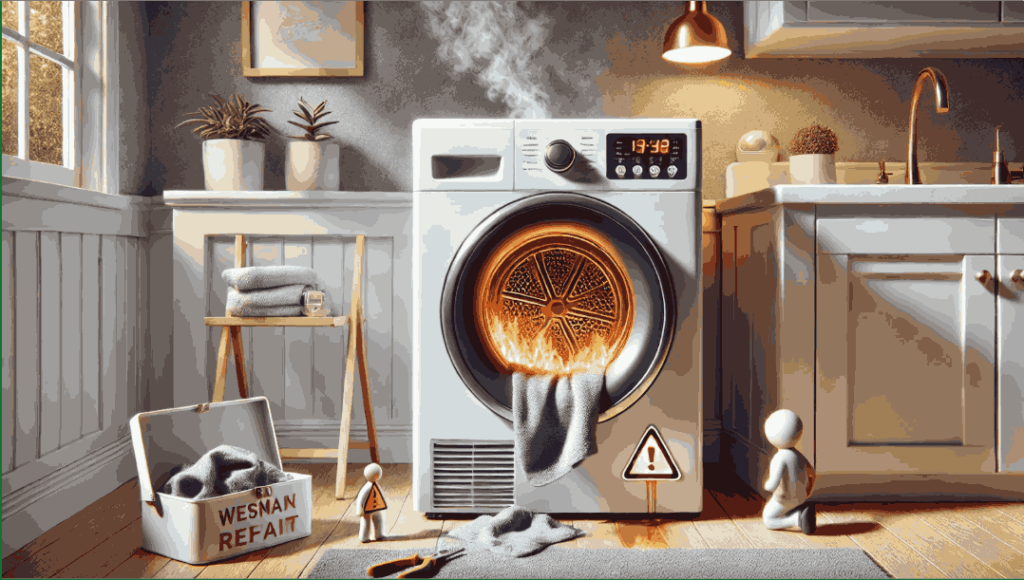As an appliance repair specialist, I’ve seen firsthand how dangerous overheating dryers can be. Many people don’t realize that this convenient household appliance can become a fire hazard if not properly maintained. Clogged vents, overloaded filters, and malfunctioning sensors can all lead to serious problems. However, with proper care and early detection of issues, you can prevent both minor malfunctions and major disasters.
The Most Common Cause of House Fires – Have You Overlooked It?
Most people assume that house fires are primarily caused by electrical wiring issues or faulty gas stoves. However, statistics show that one of the leading causes of home fires is dryer-related fires, and in almost every case, the culprit is lint buildup.
I’ve taken apart dryers where the vent system was completely clogged with lint and dust. Not only does this reduce efficiency, but lint is also highly flammable when exposed to high temperatures. A client in San Antonio once called me after noticing a burning smell coming from their dryer. Upon inspection, I found a thick clump of lint stuck in the exhaust duct, which had started to smolder. After thoroughly cleaning the vent and replacing a worn-out filter, the dryer was safe to use again.
To avoid this, you should clean the lint filter after every cycle and check the exhaust vent at least every few months.
Why Is Your Dryer Overheating, and How Can You Fix It?
If your dryer’s exterior becomes excessively hot while running, this is a clear sign of a malfunction. Overheating is often caused by restricted airflow due to a clogged vent system. When hot air cannot escape efficiently, the dryer overheats, putting extra strain on its components.
A customer in San Antonio once called me because their dryer kept shutting off mid-cycle. After an inspection, I discovered that the thermal fuse had blown due to excessive heat buildup. The cause? A completely clogged vent, which forced the motor to work at full power. After cleaning the ducts and replacing the fuse, the dryer functioned properly again.
If your dryer is getting hotter than usual, don’t ignore it. Check the ventilation system, and if the issue persists, call a technician.
Clothes Still Damp After a Full Cycle – Is It the Laundry or the Machine?
If your clothes come out damp after a full drying cycle, the issue might not be with the laundry but with the dryer itself. The first thing to check is whether the drum is overloaded—if it’s packed too tightly, hot air can’t circulate properly.
However, sometimes the problem is caused by a faulty moisture sensor. A customer in San Antonio complained that their dryer was no longer drying clothes as effectively as before. After diagnosing the issue, I found that the sensor was coated in a layer of detergent residue and lint, which prevented it from accurately detecting moisture levels. Once the sensor was cleaned, the dryer resumed working normally.
Another common cause is a burned-out heating element. If your dryer runs but doesn’t produce heat, the heating element may have failed, and in this case, replacement is necessary.
Which Dryer Parts Require Regular Maintenance (But Are Often Overlooked)?
Aside from cleaning the lint filter, dryers have other components that require routine maintenance. Moisture and temperature sensors, for example, can accumulate residue over time, causing them to malfunction. Cleaning them every few months can help prevent drying issues.
Another commonly overlooked component is the drum belt. Over time, it stretches and wears out, potentially snapping and rendering the dryer useless. I once had a customer call about a dryer that turned on but wasn’t spinning. The cause? A worn-out belt that had lost its tension and slipped off. After replacing it, the dryer worked like new again.
It’s also important to check ventilation openings on the dryer’s body. If they become blocked with dust, airflow is restricted, increasing the risk of overheating.
5 Dryer Myths That Could Lead to Costly Repairs
- “The lint filter only needs cleaning once a month.” In reality, it should be cleaned after every cycle. Even small amounts of lint buildup can reduce efficiency and increase fire risk.
- “Dryers don’t require maintenance.” All appliances need upkeep. Without cleaning the vents and checking key components, your dryer’s lifespan will be significantly shortened.
- “If a dryer isn’t drying, the heating element is broken.” Not necessarily. The problem could be a clogged vent, a faulty moisture sensor, or even a power supply issue.
- “You can place a dryer flush against the wall.” Actually, dryers need clearance space to allow for proper airflow and prevent overheating.
- “Loud noises from a dryer are normal.” Unusual noises like grinding or squeaking can indicate worn-out drum bearings, a slipping belt, or a failing motor. These signs should never be ignored.
The Benefits of Professional Repair
If your dryer is overheating, making strange noises, or failing to dry clothes properly, attempting a DIY repair can be risky. Dryers contain high-voltage components and powerful heating elements, making them dangerous to disassemble without proper knowledge.
If you need dryer repair in San Antonio, calling a professional is the safest choice. The experts at Superior Appliances Repair https://superiorappliancesrepair.com/san-antonio/ provide on-site diagnostics, use high-quality replacement parts, and offer service warranties. Instead of putting your safety at risk, trust experienced professionals to restore your dryer to proper working condition.
A dryer is a valuable household appliance, but it requires proper care. By regularly cleaning filters, maintaining ventilation, and addressing issues promptly, you can extend its lifespan and ensure safe, efficient performance for years to come.







